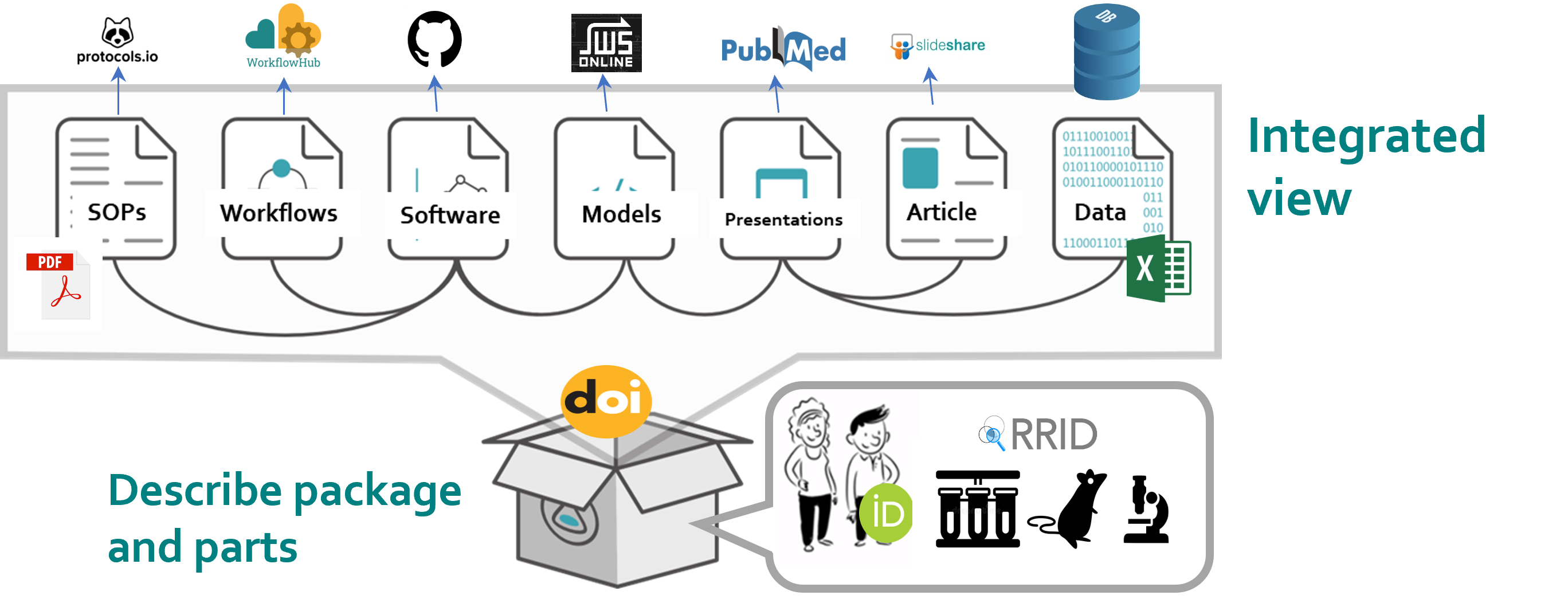About RO-Crate
Table of contents
- About RO-Crate
- What is an RO-Crate?
- Applications of RO-Crate
- How RO-Crate makes your research FAIR
- Where do I start?
- Cite RO-Crate
About RO-Crate
RO-Crate aims to help people make their research FAIR (Findable, Accessible, Interoperable, and Reusable). Have you encountered questions like these?
- Researcher: How can I ensure people know how to (re)use my data and reproduce my analysis?
- Data consumer: How do I find and make sense of a dataset with a thousand cryptically named files?
- Data steward: I’m part of a new, large project - how can we manage the data we produce FAIRly?
These are all metadata questions that RO-Crate is designed to answer.
What is an RO-Crate?
An RO-Crate is an integrated view through which you can see an entire Research Object; the methods, the data, the output and the outcomes of a project or a piece of work. Linking all this together enables the sharing of research outputs with their context, as a coherent whole.
RO-Crates link data and metadata no matter where they are stored – so that from a paper, you can find the data, and from the data, you can find its authors, and so on.
For example, an RO Crate won’t just contain an author’s name. It would also contain their ORCID, which in turn is connected to their affiliations, their funding, and their other publications.

Image credit: Goble, C. (2024, February 16). FAIR Digital Research Objects: Metadata Journeys. University of Auckland Seminar, Auckland. Zenodo. https://doi.org/10.5281/zenodo.10710142
Applications of RO-Crate
An RO-Crate is a structured package for sharing research data. It can:
- Contain files and link to large datasets stored online
- Record an entire analysis, including inputs, outputs, and tools used
- Connect related publications and datasets
- Preserve datasets for long-term archiving
- Combine multiple uses to fit different needs
RO-Crate is used in fields like bioinformatics, digital humanities, and regulatory sciences. Different communities can also adapt and extend it to their specific data and requirements.
How RO-Crate makes your research FAIR
Findable: RO-Crates can be published to repositories like Zenodo and given a DOI, just like any other data. The linked metadata helps consumers of the RO-Crate to find related work, people, and organisations.
Accessible: RO-Crate is compatible with FAIR Signposting, enabling the metadata to be retrieved automatically as long as you have the DOI or other persistent identifier.
Interoperable: RO-Crate is based on standard, widely-used web technologies (including JSON-LD and schema.org), making it usable and interoperable across platforms. It is flexible enough to reference any kind of external (meta)data, whether that external data uses RO-Crate itself or not.
Reusable: RO-Crate is designed to capture detailed provenance. For example, an RO-Crate could include a full representation of the individual steps executed as part of an analysis, including the inputs, outputs, computational environment, and the researchers involved.
RO-Crate, when combined with FAIR Signposting, is a practical implementation of the FAIR Digital Object Framework.
Where do I start?
Learn by example
To learn more about RO-Crate there are some tutorials and resources here.
You can also visit the Use Cases page to browse projects using RO-Crate, or find relevant information for your domain, project role, or task.
Quick technical overview
For a technical introduction to RO-Crates see RO-Crate Technical Overview.
Read the Background page to learn about the history of RO-Crate and its predecessors.
Speak to the RO-Crate Team
Come to one of our drop-in sessions suitable for all levels, or email the team at ro-crate@researchobject.org.
See the Community pages for more information.
FAQ
Check the FAQ for answers to common questions.
Cite RO-Crate
Cite RO-Crate as project/approach
Stian Soiland-Reyes, Peter Sefton, Mercè Crosas, Leyla Jael Castro, Frederik Coppens, José M. Fernández, Daniel Garijo, Björn Grüning, Marco La Rosa, Simone Leo, Eoghan Ó Carragáin, Marc Portier, Ana Trisovic, RO-Crate Community, Paul Groth, Carole Goble (2022):
Packaging research artefacts with RO-Crate.
Data Science 5(2)
https://doi.org/10.3233/DS-210053
Cite RO-Crate Specification (any version)
Peter Sefton, Eoghan Ó Carragáin, Stian Soiland-Reyes, Oscar Corcho, Daniel Garijo, Raul Palma, Frederik Coppens, Carole Goble, José María Fernández, Kyle Chard, Jose Manuel Gomez-Perez, Michael R Crusoe, Ignacio Eguinoa, Nick Juty, Kristi Holmes, Jason A. Clark, Salvador Capella-Gutierrez, Alasdair J. G. Gray, Stuart Owen, Alan R Williams, Giacomo Tartari, Finn Bacall, Thomas Thelen, Hervé Ménager, Laura Rodríguez Navas, Paul Walk, brandon whitehead, Mark Wilkinson, Paul Groth, Erich Bremer, LJ Garcia Castro, Karl Sebby, Alexander Kanitz, Ana Trisovic, Gavin Kennedy, Mark Graves, Jasper Koehorst, Simone Leo, Marc Portier (2020):
RO-Crate Metadata Specification
researchobject.org / Zenodo
https://doi.org/10.5281/zenodo.3406497
For citing a particular version of RO-Crate specification see its embedded Cite this version DOI.